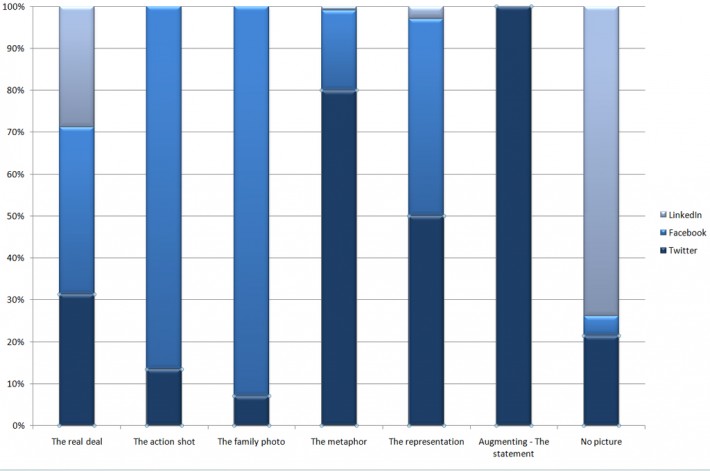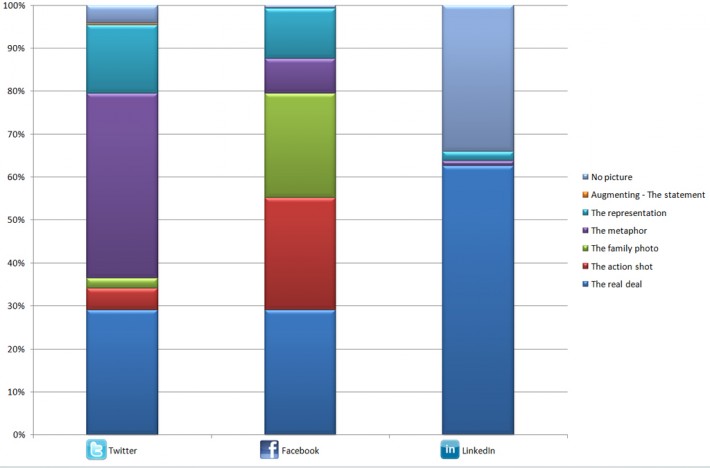An avatar analysis: Choosing your profile picture
I was recently asked the question about my profile picture: “why a cartoon?” My response takes me on a journey through options not chosen and an analysis of the choices of others.

The value of a picture
In the digital space, we do not have the luxury of forming an opinion based on body language, tonality, or other non-verbal forms of visual communication. I paint a picture of who you are based on 1) what you write in your blogs, your Facebook and Twitter posts and comments, your LinkedIn profile, and sites your recommend. I also infer your characteristics from 2) other’s comments about you, their recommendations in professional forums, and what kind of people pass on your comments. Finally, my opinions are formed from 3) people you associate with, including Facebook friends, Twitter followers, or LinkedIn connections.
Relying on these textual depictions, the only graphical image I have of you is the one I create in my mind’s eye. That is, of course, until you provide me with a profile picture. This seemingly small piece of illustrative information removes my need for imagination and provides a crucial link between my depiction of you and the identity you hold for yourself.
How to choose your profile picture
The decision-making priocess for your profile picture is the topic of advice, interviews, and psychological study. Many do not understand or care about the gravity of the pictorial personae, while others embrace the opportunity for strategic expression with open arms. Some break your options down to over 30, others 10, some focus on a profession like CIOs, some focus on an application such as dating sites, and others are gender specific.
In an attempt to clarify whilst adding to the noise, I consolidate your options into five broad catagories:
| The real deal | |
 |
The confident head and shoulders photo, with a practiced smile. I recommend this as your only option for a LinkedIn profile. You are saying “This is who I am, like it or… well, just please like it.” |
| The action shot | |
 |
You are saying: “I am fun, a traveller, playful, crazy, and/or sporty. I live life and want you to know it.” Some words of warning: unless you work in entertainment or the adult beverage industries, evidence of alcoholic overindulgence is risky for the corporate career climbers. Clothes are always mandatory, and your middle finger is not one half of a peace sign. |
| The family photo | |
 |
These people are a significant part of your life. You want to share your bond. We appreciate that you are happy, and respect your sentiment. Your single friends may get depressed every time they see your photo, but that’s OK. People learn to live with envy every day. |
| The metaphor | |
 |
You are a comic book character, a landscape, a vehicle, or a building. Something you want to be, somewhere you were or want to be, or something you feel represents who you are or something you think is funny. Basically, anything not you that will still tell me something about you. What that is, I am going to have to guess. Aren’t you clever. |
| The representation | |
 |
It’s you, just viewed differently. Includes a cartoon of you, you as a kid, an artistic sketch, a close up of a body part, or some obscure profile of your head. It’s not that you are hiding or are compensating for insecurities. It’s just that… well… you know it’s not that other thing. |
| Augmenting – The statement | |
 |
A modification of any of the above for a cause. A symbol on some part of your picture (aka twibbon), a coloured border, or change your picture altogether. As I noted with the recent Facebook cartoon meme, this is usually as much about you feeling good about who you are as it is about raising awareness. The connection between viewing your picture and me taking a call to action is tenuous at best. Also, don’t forget to change your picture back after the campaign, else we think you both passionate and lazy. |
What I use, why, and when
Theresa created a cartoon image of me some time ago, which I use for my Facebook, Twitter, blog, and Skype profile pictures and most online forums. The picture captures my slight smirk and the cartoon represents the facade we all maintain in the digital space. I initially did it as an intentional statement about online identity being artificial compared to actual identity. Not that anyone got that.
Since then, I have maintained the cartoon to keep me from taking myself too seriously. In my line of work, I come across many “gurus” and “thought leaders” making a name for themselves in the digital space. I occasionally catch myself at risk of getting serious about professional personal brand management, to which my profile picture offers me a reality check.
My LinkedIn account, however, is the real deal. In contrast to most of my Facebook and Twitter friends and followers, I engage with my LinkedIn connections in some form of the commercial mandate. I play it straight based on the assumptions that there are a few who may not wish to trust their profit margins to a cartoon.
I also keep my profile picture fairly consistent. Once you get past a few hundred friends or people you follow, keeping up to date across the channels is an exercise in scanning. When someone changes their profile picture, I have to relearn to associate the picture with who they are. I appreciate creativity, but it messes with my social media mojo. I resist the urge for change based on a suspicion others may feel the same.
What others (I know) use
A complete analysis of what type of profile everyone in the world is using is beyond my capabilities or commitment to the cause. I can, however, take a quick peek at my 91 LinkedIn connections, my 275 Facebook friends, and the 216 people I follow on Twitter. I will pre-empt the results with the acknowledgement that it was somewhat subjective, in that there can be some mixing of family and action shots (eg., the beach wedding scene), and there is some blurring between metaphor and representation (is that your eyeball closeup of someone else’s?).

The Real Deal is split evenly between the channels, due likely to it being the least risk for the average user. The Action Shot and The Family Photo are dominant in Facebook, likely due to the inherent personal community aspect of the medium. The Metaphor results are skewed in Twitter due to the pervasiveness of commercial participation, polluting the results with logos. The Representation is evenly split between Facebook and Twitter, which can be viewed as a need to either express creativity or hide behind a facade, depending upon your perspective.
Augmentation for a cause was almost non-existent, with one instance in Twitter. Among the many conclusions we can come up with, this could mean I follow self-adsorbed people, most people in social media are self-adsorbed, or modifying your profile picture for a cause is not that pervasive. Finally, LinkedIn reflected the most users without a profile picture, perhaps due to the greater significance of representing yourself professionally. Twitter followed next, although many with no picture had abandoned accounts and Twitter has in the past periodically deleted profile pictures. A lack of profile picture in Facebook is more noticeable and perhaps easier to update, hence the greater propensity of users with a picture in the channel.

Viewing the penetration of profile picture types within each channel, Twitter is dominated by The Real Deal and The Metaphor. Facebook is evenly distributed across the profile types, with slightly less representation of the metaphor due to the personal nature of the community. LinkedIn is almost exclusively The Real Deal, for those who have a profile picture.
So where do you fit? And why? Your profile picture is an important piece of your “personal digital brand identity”. How much that matters in the big scheme of things is a topic for another post.


good post 🙂
I’m always impressed that you take the time to gather statistics…I just make them up 🙂
I’d be interested to see which pictures you classify as The Real Deal over Action Shots. For example, my LinkedIn profile has a photo taken of me climbing a rope structure thing while camping out near Kenilworth, so it is an action shot…but, most of it is cropped so you cannot really tell, and it is a representation of my professional self as I use the same picture on work’s internal chat client, collaboration/community sites and general staff profile. If I was working in a stricter corporate environment though, I would probably have a picture of me in the suit which I don’t actually own.
Yours was a potential for either. I did wonder how you got that angle. You raise an interesting point, however. If you were to dress in a suit, would that indeed be “The real Deal”, or would it be more of a representation? Hmmm… fodder for another post… 🙂
Nice post. 🙂
My FB pic is a candid black/white of me hugging my daughter. She was very tired, fussy and ready to go home. I’m smiling because she had just fallen and “hurt” herself. It was definitely no big deal and I was amused at the fuss she was making of it.
I use it because it’s not a bad picture of me. I’m not very photogenic — at least I don’t think so. I keep it because it works and I’m too lazy to change it or add new ones. 😉